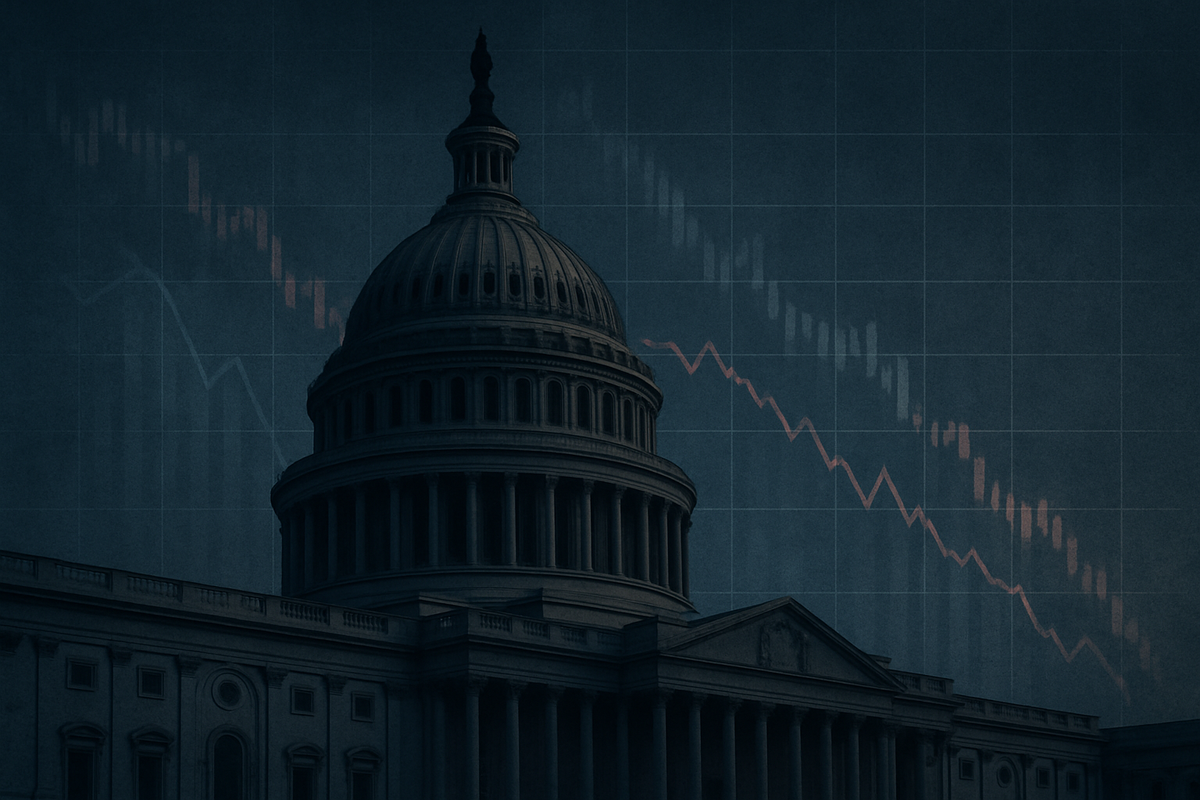
The United States federal government finds itself in the throes of a shutdown, now entering its third week as of October 16, 2025. This fiscal impasse, stemming from a failure in Congress to pass appropriations legislation for the 2026 fiscal year, is casting a long shadow over the nation's economy and injecting a palpable sense of uncertainty into the financial markets. While historical precedents suggest a degree of market resilience to such political gridlock, the prolonged nature of this current shutdown, the third under President Donald Trump, is raising concerns about accumulating economic damage and its potential to erode investor confidence.
The immediate implications are far-reaching, impacting hundreds of thousands of federal employees, disrupting vital government services, and creating a ripple effect across various industries. Analysts are estimating a significant weekly reduction in US GDP growth, with projections ranging from 0.1 percentage points, or $7 billion, to a more alarming $15 billion per week. This sustained economic drag, coupled with a growing "data blackout" as key economic reports are suspended, leaves both policymakers and investors grappling in the dark, heightening the risk of misinformed decisions and prolonged market volatility.
The Gridlock's Grasp: Details, Timeline, and Initial Market Response
The current government shutdown commenced on October 1, 2025, following an inability of Congress to reconcile differences on federal spending levels, foreign aid rescissions, and health insurance subsidies. This partisan standoff has led to the furloughing of approximately 900,000 federal employees, while another 700,000 are working without pay, creating immediate financial hardship for these individuals and the communities reliant on their salaries. Key players in this legislative stalemate include the Democratic and Republican leadership in Congress, along with the White House under President Donald Trump.
The timeline leading to this moment has been characterized by escalating tensions and failed negotiations, culminating in the expiration of funding on September 30th. While previous shutdowns have often seen initial market volatility followed by a rebound, the extended duration of this current event is beginning to shift sentiment. Historically, the S&P 500 has demonstrated resilience during shutdowns, often posting gains. For instance, during the 35-day shutdown of 2018-2019, the S&P 500 surged 10.3%. However, the accumulating costs of the present shutdown – estimated to potentially lead to an additional 43,000 unemployed workers and a $30 billion reduction in consumer spending if it lasts a month – are causing growing apprehension. The market's initial reaction has been mixed, with some sectors showing resilience while others, particularly those with direct government ties, face increasing pressure.
Public Companies on the Brink: Winners and Losers
An ongoing government shutdown creates a distinct landscape of winners and losers among public companies, primarily based on their reliance on federal contracts, regulatory approvals, or consumer spending patterns.
Potential Losers:
- Federal Contractors: Companies heavily reliant on government contracts, such as defense contractors like Lockheed Martin (NYSE: LMT) or IT service providers like Booz Allen Hamilton (NYSE: BAH), face significant disruption. New contract awards are generally prohibited, existing contracts may be affected by furloughed oversight personnel, and payments can be delayed. This can lead to project halts, revenue recognition issues, and a slowdown in new business.
- Small Businesses: The Small Business Administration (SBA) halts loan and loan guarantee approvals, cutting off a critical lifeline for many small enterprises. This impacts a vast network of suppliers and service providers, potentially leading to cash flow crises and insolvencies.
- Travel and Tourism: Companies in the travel and leisure sector, including airlines like Delta Air Lines (NYSE: DAL) and hotel chains like Marriott International (NASDAQ: MAR), can suffer from reduced consumer confidence and operational disruptions. National parks may close or operate with limited services, and air travel could experience longer security lines due to unpaid TSA agents.
- Science and Health: Pharmaceutical companies and research institutions that rely on federal grants or regulatory approvals from agencies like the National Institutes of Health (NIH) or the Food and Drug Administration (FDA) could see research halted, new drug approvals delayed, and grant applications suspended.
- Agriculture: Companies involved in agricultural products and services may face delays in essential USDA functions, including visa processing for seasonal workers, pesticide registrations, and the release of crucial agricultural data. This could impact agricultural giants like Archer-Daniels-Midland (NYSE: ADM) or smaller, specialized farming operations.
- Housing and Infrastructure: The Federal Housing Administration (FHA) may stop insuring some new mortgages, impacting real estate companies and homebuilders like D.R. Horton (NYSE: DHI). Delays in permitting and execution of critical infrastructure projects could also affect construction and engineering firms.
Potential Winners (or less impacted):
While direct "winners" are scarce, companies in sectors less reliant on direct government interaction or those providing essential services that continue uninterrupted may fare relatively better. For instance, utility companies or consumer staples providers might see less direct impact. However, the overall drag on consumer spending and economic activity will likely affect most businesses to some degree. Safe-haven assets like U.S. Treasury bonds often see increased demand, but this benefits bondholders rather than specific public companies.
Wider Significance: Trends, Ripple Effects, and Historical Echoes
The ongoing government shutdown is not an isolated incident but rather a symptom of broader industry trends, notably escalating political polarization and concerns over the nation's high government debt. The repeated inability of Congress to reach consensus on fundamental fiscal matters signals an underlying instability that can deter long-term investment and planning. This event exacerbates existing anxieties about the national debt, which continues to grow, potentially impacting the U.S. dollar's standing and global financial stability in the long run.
The ripple effects of this shutdown extend far beyond the directly impacted federal agencies and employees. The "data blackout," resulting from the suspension of critical economic reports such as U.S. jobs reports and Consumer Price Index (CPI) data, leaves the Federal Reserve and investors "flying blind." This lack of reliable information hinders accurate economic assessment, potentially leading to misinformed monetary policy decisions and increased market volatility once data becomes available. Competitors and partners of affected federal contractors and small businesses will also feel the squeeze, as supply chains are disrupted and payments are delayed.
Regulatory and policy implications are severe. Routine inspections by the FDA are curtailed, environmental reviews by the EPA are halted, and financial regulatory approvals are delayed. This can create backlogs that take months to clear, affecting everything from food safety to new business formation. Historically, there have been 20 government shutdowns lasting a day or more since 1976. The longest was 35 days in 2018-2019, which, paradoxically, saw the S&P 500 surge. However, analysts caution that the current economic climate, with concerns about inflation and the Federal Reserve's delicate balancing act, makes the 2025 shutdown a potentially more impactful event than past, shorter closures, especially as its duration extends beyond historical averages.
What Comes Next: Navigating the Uncertainty
The path forward for the US economy and stock market hinges critically on the duration and eventual resolution of the ongoing government shutdown. In the short term, continued economic drag is inevitable, with the accumulating weekly GDP losses translating into a more significant hit to quarterly economic growth. The pressure on federal employees and businesses will intensify, potentially leading to more widespread financial distress and a further reduction in consumer spending.
Strategic pivots will be essential for businesses. Companies heavily reliant on government interaction may need to diversify their client base or build larger cash reserves to weather future political uncertainties. The absence of reliable government economic data means that investors and businesses will have to rely more on alternative data sources and qualitative assessments, which could lead to increased market fragmentation and divergent analyses.
Market opportunities in this environment are scarce, largely overshadowed by significant challenges. The primary challenge remains the "data blackout," which makes it difficult to ascertain the true health of the economy. This uncertainty could lead to a deeper market correction if the shutdown persists and economic damage becomes more pronounced. Potential scenarios range from a swift resolution driven by public pressure and a subsequent market rebound, to a prolonged stalemate that inflicts lasting damage on economic growth and investor confidence. A quick resolution, while still incurring unrecoverable costs, would likely be met with a sigh of relief by the markets, potentially leading to a sharp, but temporary, rally.
Wrap-up: Assessing the Lasting Impact
The ongoing US government shutdown serves as a stark reminder of the fragility of economic stability in the face of political gridlock. The key takeaway from this event is the accumulating cost: each day the shutdown continues, the economic damage grows, impacting federal employees, small businesses, and a myriad of industries. While the stock market has historically shown resilience during such events, the extended duration of the 2025 shutdown, coupled with the absence of critical economic data, presents a unique and concerning challenge.
Moving forward, the market will remain highly sensitive to any signs of a breakthrough in negotiations. Investors should anticipate continued volatility until a resolution is reached. Even after the government reopens, there will be unrecoverable economic costs, such as lost productivity and delayed investments, which could have a lasting impact on certain sectors and the overall economic growth trajectory. The erosion of public trust in governmental stability could also have long-term implications for investor sentiment and the nation's global economic standing.
What investors should watch for in the coming months includes the duration of the shutdown, any compromise proposals emerging from Congress, and the initial economic data releases once government agencies resume full operations. These data points will be crucial for understanding the true extent of the shutdown's impact on Q4 GDP, employment figures, and inflation. Ultimately, while markets often rebound, the frequency and duration of these political impasses highlight a systemic risk that savvy investors must factor into their long-term strategies.
This content is intended for informational purposes only and is not financial advice





